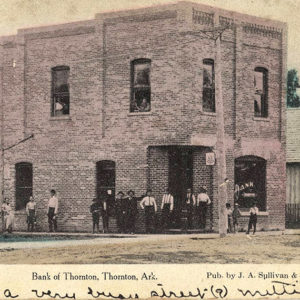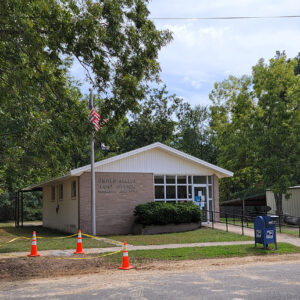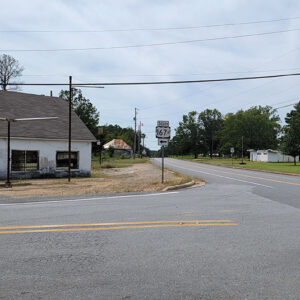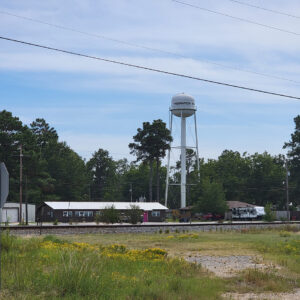calsfoundation@cals.org
Thornton (Calhoun County)
| Latitude and Longitude: | 33°46’44″N 092°29’31″W |
| Elevation: | 318 feet |
| Area: | 1.92 square miles (2020 Census) |
| Population: | 339 (2020 Census) |
| Incorporation Date: | December 13, 1890 |
Historical Population as per the U.S. Census:
|
1810 |
1820 |
1830 |
1840 |
1850 |
1860 |
1870 |
1880 |
1890 |
1900 |
|
– |
– |
– |
– |
– |
– |
– |
– |
406 |
– |
|
1910 |
1920 |
1930 |
1940 |
1950 |
1960 |
1970 |
1980 |
1990 |
2000 |
|
611 |
1,312 |
550 |
– |
– |
658 |
746 |
711 |
502 |
517 |
|
2010 |
2020 |
|
|
|
|
|
|
|
|
|
407 |
339 |
|
The city of Thornton developed on the St. Louis and Southwestern Railway (often called the Cotton Belt) four miles southwest of Fordyce (Dallas County) in 1883. A center of the timber industry, it became, for a time, the largest city in Calhoun County.
Evidence of prehistoric activity in the region that would become Calhoun County is seen in several Native American mounds located in the county. At the time of the Louisiana Purchase, the area was understood to belong to the Caddo, but their dwellings tended to be in river valleys to the south of the heavy pine forests of south-central Arkansas. White settlers did not make a permanent home in the pine forests until after the Civil War, when northern investors changed the face of Arkansas by developing the railroads and the timber industry.
Arkansas’s new railroads connected some older cities, such as Pine Bluff (Jefferson County) and Camden (Ouachita County), while bypassing other established settlements. They also created new communities such as Fordyce and Thornton. The latter, incorporated in 1890, was named for J. R. Thornton, a prominent attorney in Camden. Thornton grew quickly due to the timber industry, especially that of the Stout Lumber Company, which owned 70,000 acres of pine forest in northern Calhoun County and in adjacent counties. James Huff Stout, a Wisconsin lumberman, headed the lumber company in Thornton until his death in 1910. In addition to forests and sawmills, the company constructed houses for its employees, built the O’Roarke Hotel in Thornton, and created a shortline railroad—the Thornton and Alexandria Railway—which ran eighteen miles from Thornton into the pine woods to convey harvested lumber to the mill for processing and then on to the Cotton Belt tracks. The company was unique in that it employed numerous Mexican workers in addition to white and African-American workers.
Businesses in Thornton during its heyday included three general stores, three drugstores, and a butcher, as well as a co-operative store known as “Temperance Hall.” In addition to its logging operation, the city was also regarded as a local center for hunters to gather.
A devastating fire on December 25, 1925, destroyed the Stout sawmill and offices. Although other sawmills remained—Buchanan & Company, and W. B. Pearson—when Thornton’s primary employer decided not to rebuild, the city began a rapid decline. The onset of the Great Depression (which was under way in Arkansas, due to low prices for timber, cotton, and other crops, well before the stock market crash in 1929) prevented any hope of recovery for the city, and more than half the population of Thornton had left before the 1930 census. That year, the remaining citizens voted to surrender the charter of the city, and for the next two decades, Thornton was unincorporated.
By 1951, the remaining residents desired city services, including a water and sewer system, and so they voted to reincorporate the city. By 1958, they had completed the water system, installed street lights, and purchased a fire truck for the volunteer fire company. Chapters of the Lions Club, Boy Scouts, and Girl Scouts had also been established. Citizens Bank had a branch in the city, and other small businesses were operating.
Another factor in the revitalization of Thornton was the improving highway system. U.S. Highway 79 runs alongside the Cotton Belt tracks, allowing men and women to work in Fordyce but live in Thornton. Schoolchildren have been bussed to the Bearden (Ouachita County) school system since the school districts were consolidated in 1985. A bridge built near Thornton on State Highway 274 in 1940 was added to the National Register of Historic Places in 1995.
The population of Thornton in the 2010 census was 407, which includes 265 whites, 126 African Americans, and eleven Hispanics. Churches in Thornton include three Baptist churches, one African Methodist Episcopal (AME) church, and one United Methodist church. The town also has a public library.
John Roy Steelman, an advisor to President Harry S. Truman, was born on a farm near Thornton in 1900. Susan Newton worked as a bookkeeper at the Stout Lumber Company in Thornton during the 1920s before marrying William Pryor of Hampton (Calhoun County); she was a pioneer for women in Arkansas politics and was the mother of David Pryor, who was governor of Arkansas and then U.S. senator.
For additional information:
Deane, Ernie. “Town of Thornton’s on the Way Back.” Arkansas Gazette, January 11, 1959, p. 5E.
A Pictorial History of the Fordyce Area. Fordyce, AR: KBJT & KQEW Radio, 1992.
Steven Teske
Butler Center for Arkansas Studies
 Bank of Thornton
Bank of Thornton  Calhoun County Map
Calhoun County Map  Entering Thornton
Entering Thornton  Thornton Post Office
Thornton Post Office  Thornton Street Scene
Thornton Street Scene  Thornton Street Scene
Thornton Street Scene  Thornton Street Scene
Thornton Street Scene  Thornton Water Tower
Thornton Water Tower 




Comments
No comments on this entry yet.